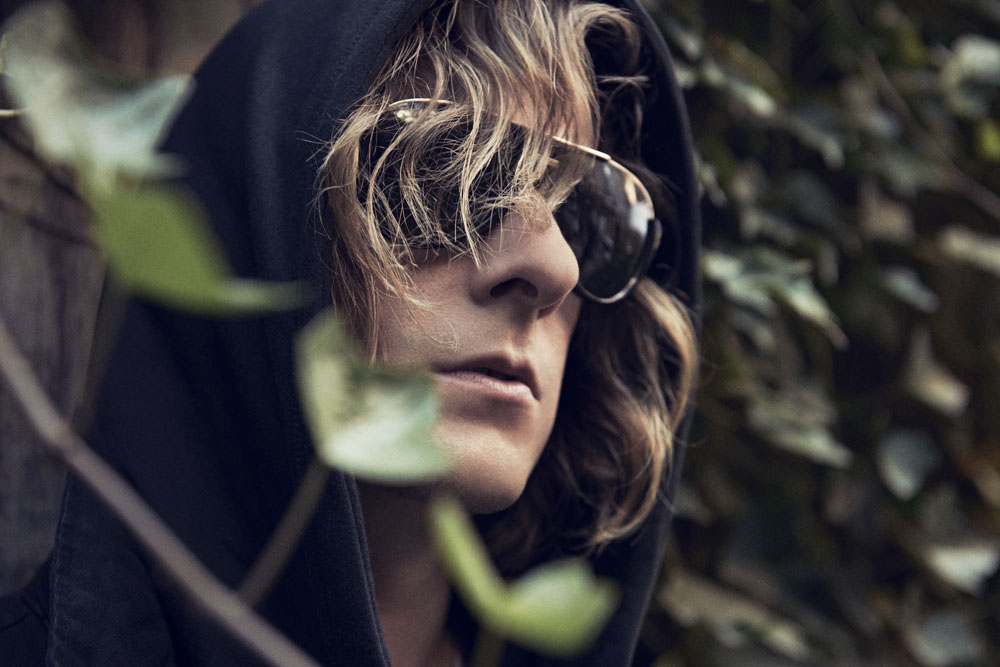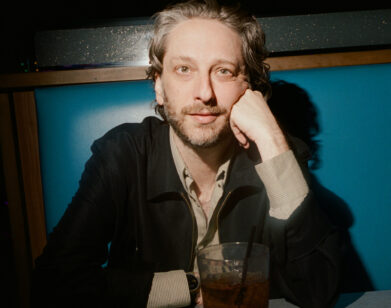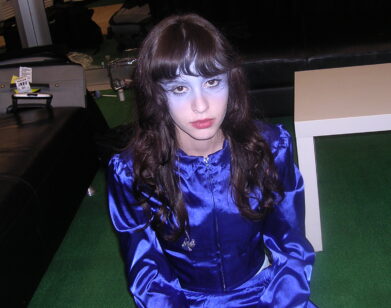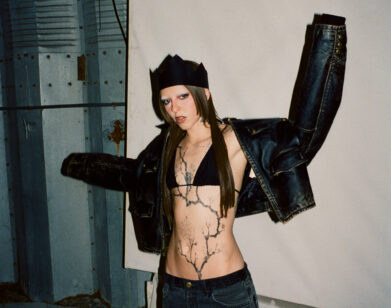Brian DeGraw
EVERY NIGHT OF MY LIFE WAS DEEJAYING AND GOING OUT TO TRY TO ESCAPE MY LITTLE BOX OF AN APARTMENT . . . I STARTED LOSING MY MIND A LITTLE BIT. I JUST WANTED TO BREAK OUT. Brian DeGraw
As a founding member of the band Gang Gang Dance, musician and visual artist Brian DeGraw has had a heavy hand in igniting (and some might say keeping alive) the flickering heartbeat of downtown New York City art rock. Equal parts improvisational, mystical, and coolly calculated, Gang Gang Dance evolved into a finely tuned point of influence by effortlessly fusing experimental music with a fine-art sensibility over the course of five full-length albums. This December, though, the 39-year-old DeGraw will step out on his own to release his first ever solo effort, SUM/ONE (4AD). Released under the nom de plume bEEdEEgEE and recorded over the past year at W0RMB1N, DeGraw’s studio in Woodstock, New York, the synth- and sample-heavy album reveals a more beat-driven and wholly electronic side of his work. Featuring vocal contributions from the likes of Hot Chip’s Alexis Taylor and fellow Gang Gang Dance member Lizzi Bougatsos, SUM/ONE treads a fine line between the kind of electronic psychedelia best consumed via a good pair of headphones and the Technicolor dance music that would play at a rave held in the middle of some parallel (and perhaps LSD-soaked) universe. It also says something about the extreme diversity of DeGraw’s creative output that even a record as stylistically broad and fundamentally challenging as SUM/ONE, is, according to DeGraw, “the least weird record I’ve ever made.”
T. COLE RACHEL: When did you first come to New York?
BRIAN DEGRAW: In ’98.
RACHEL: Did you come to pursue music or art?
DEGRAW: I was doing both, same as I do now, but I had left D.C. more for reasons of dead-ending in the visual art scene. I was in a band there called the Cranium, and we sort of moved together to New York, but my main reason for moving here was to pursue visual art.
RACHEL: How long was it after that that Gang Gang Dance really started?
DEGRAW: We started officially in 2000, I think. There were different versions of it beforehand with a few different people, but we really decided to be a band in 2000 and give it a name and all that. That was after playing a Halloween party at the Pat Hearn Gallery, where Colin de Land had asked us to perform. That was the first time we played with Lizzi. After that night, we decided to make it a permanent thing.
RACHEL: I remember seeing you guys play during that era in a lot of different permutations and in a lot of crazy spaces. It was interesting to see Gang Gang Dance slowly congeal into an actual band.
DEGRAW: Yeah. I mean, for the first four years we basically just improvised. We would have very vague ideas—moods that we wanted to explore—but we didn’t really rehearse any songs. Around 2004 or 2005 was when we started actually structuring songs and practicing them.
RACHEL: It’s always been interesting to see the way Gang Gang is written about. To this day, people don’t really seem to know how to categorize you. Even now, more than a decade in, the band is still kind of on the outside, which I think is cool.
DEGRAW: Yeah. For sure. We took a lot of pride in that, even though we didn’t design it to be that way. I think everyone in the band was really opposed to any kind of trend whatsoever, even if it was to a fault sometimes. I think we could have benefited from loosening up on that a bit, but still, that’s why it was the way it was. Everyone was so anti-wanting to be anything else. I guess a lot of bands say that but I think, for us, that notion—combined with our musical influences—ended up making us uncategorizable.
RACHEL: This new record, SUM/ONE, is your first proper release outside of the band. Have you been itching to do some kind of solo project for a long time now?
DEGRAW: Not so much, but there were definitely certain things I started developing throughout the course of the band that didn’t really apply. I mean, anything can be applied to what Gang Gang does, but there were some things that just weren’t really working. Even something as simple as using a sequencer. That was something I didn’t necessarily want to do in Gang Gang, but it interested me in general. I was interested in programming beats and stuff like that. That’s something we never did in Gang Gang because our music is all so based on improvisation. But I’m always kind of making things no matter what, and they end up finding a place, whether it’s Gang Gang or elsewhere.
RACHEL: How did this record come to be then?
DEGRAW: It was really a result of me leaving the city. I’m living in Woodstock now. I was just here by myself and continuing to make things. Gang Gang has basically been on a yearlong break, so rather than continuing to work on stuff for that, I decided to make music with no real idea of what to do with it. I was working with a less specific aesthetic goal. A lot of it was just actually learning how to use new equipment, how to record myself and do things I just never had time to do before—technical things, experimenting. And that’s also why, when you listen to the record, there’s a lot of contrasting genres in there. I just threw everything in. [laughs] It’s not necessarily this unified aesthetic of a record. It’s a little bit all over the place because none of it was initially intended to be a record.
RACHEL: Ostensibly this could be considered a dance record—and there are elements of it that very much are that. But taken as a whole, it’s so much weirder.
DEGRAW: It’s interesting, because in a way, it’s actually the least weird record I’ve ever made. Individually, the tracks are much less out-there than most of the stuff I’ve ever done in my other band, but when you put it all together, it’s just really strange as a whole.
RACHEL: After playing in a band for so long, doing something like this album must be liberating.
DEGRAW: It’s a new freedom, for sure. The nature of the band is very open, but it’s still a band and it still has to operate with other people, and that involves compromise. So this is interesting because it’s the first time I’ve ever done anything completely on my own. Even performing live—I’m just now figuring out what I’m going to do, and it’s exciting because I actually have no clue. I literally started last night working on how to approach that. I was kind of dreading starting it. [laughs] But once I started working, I realized I could just do anything. It feels great.
RACHEL: Gang Gang Dance has such a funny reputation. The band has also come to represent an entire genre, or perhaps more fittingly, a specific kind of creative ethos. Saying that something had a very Gang Gang Dance vibe became like a shorthand for what people would describe as an art-rock, downtown, New York sensibility.
DEGRAW: For sure. All the stuff we would read about ourselves … I don’t know. There were a lot of weird terms being thrown around for a minute. It was, like, New York tribal? New tribalism? [laughs] We weren’t really down with that.
RACHEL: Terrible!
DEGRAW: Yeah, I know. We didn’t really support it or not support it, but we were definitely aware of people citing us as some kind of reference point for other things.
RACHEL: I think of you as a quintessential NYC artist. Why did you feel the need to move upstate?
DEGRAW: Mainly just space—physical space. I was having pretty bad anxiety attacks and stuff, and I think a lot of it had to do with my physical environment. Deep down I’ve always had a pretty strong connection with nature, but I’ve suppressed it for so long while living in the city. I think it caught up to me. I started really bugging out and needing wide-open space. So it was that simple. That and social anxiety. I felt like I was existing too much in nightlife. I still love it, but I didn’t realize how much I was doing, you know? Every night of my life was deejaying and going out to try to escape my little box of an apartment, usually by sitting at a bar. I’d had too much of that, and I started losing my mind a little bit. I just wanted to break out. So, for a while, I had both, but eventually I just gave up my apartment and ended up staying upstate.
RACHEL: You are also a visual artist. What kind of work are you doing these days in that respect?
DEGRAW: I just started working on some large-scale watercolor paintings. I was kind of waiting to finish all this record stuff to get back into that. A lot of my work is based in drawing. I do a lot of ink drawings, but I do other things, too, like video stuff. I mostly show my drawings and sculpture, though, and what I’m doing now is basically an extension of that on a larger scale and involving color, which I don’t use very much. I usually make just black-and-white ink drawings.
RACHEL: New York City has played such a large role in your art and your career. Do you feel like the city has changed?
DEGRAW: I feel the change. I feel the relationship with New York changing. It’s a personal relationship you have with the city when you move there. I definitely romanticize the early 2000s way more than I romanticize the last five years. As much as I prefer the city then as opposed to now, I’m sure if I were 23 and I moved to the New York of right now, I could have the same exact experience, you know? I could romanticize it in the same way 15 years down the line. I don’t know. I don’t really hate the cleaning up of New York, even though it’s not my preferred version of New York. [laughs] I also don’t want to be that bitter dude. Everyone finds their own special experience with the city no matter what.
RACHEL: How does putting out a solo record affect the future of Gang Gang Dance?
DEGRAW: Oh, I don’t think it will affect it at all. We’re on a break right now either way, and we’re just starting to figure out what we’re going to do next. But Gang Gang always takes precedence for sure. That’s my family, you know? I would never risk something else getting in the way of that. Making this record might influence the production of the next Gang Gang record, just because I’ve learned so much about production and mixing. This record was an amazing learning experience in terms of that. This time I just did everything by myself. Not one single other person touched the record outside of the people who contributed vocals. So I had to learn a lot. I had to watch a lot of YouTube tutorials. [laughs]
RACHEL: Isn’t that amazing? When you can’t figure something out, just look at YouTube and, sure enough, there’s a person showing you how to do it.
DEGRAW: Yeah. Everyone’s a genius now.
RACHEL: My friend learned how to do yoga from watching YouTube videos in his living room.
DEGRAW: [laughs] That’s how I learned yoga, too! I do yoga, like, 20 minutes a day, but the routine that I practice I initially watched on YouTube, like, two years ago. I’m still doing that same thing. YouTube University, man. It’s the best.
T. COLE RACHEL IS A BROOKLYN-BASED WRITER







